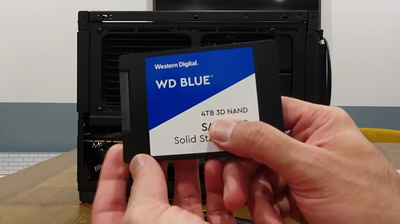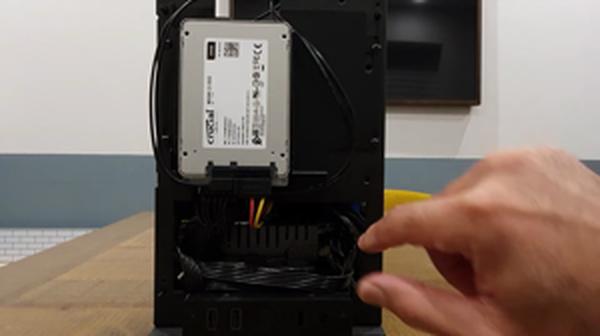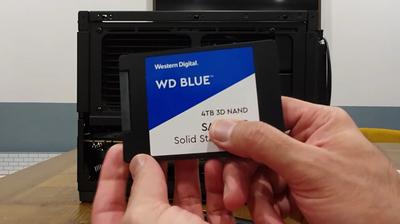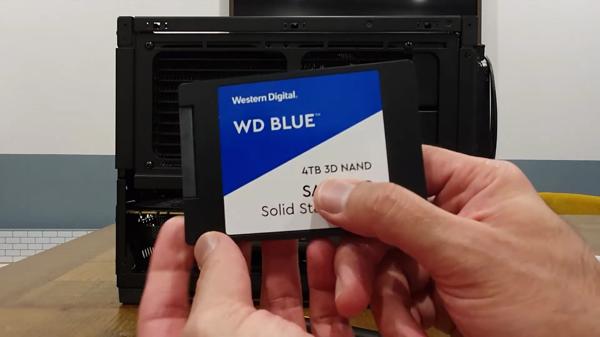
My thoughts on the Western Digital 4TB Blue 3D NAND SATA SSD WDS400T2B0A (2024)
My thoughts on the Western Digital 4TB SSD: Performance, comparing brands, setup ease, value & support.
Introduction
For a while I have been using SATA drives as well as traditional SSDS, until I got my hands on the Western Digital 4TB Blue 3D NAND SATA SSD. I've been using it for a few months now. The difference in speed and performance has been quite noticeable. I bought it when I found a great deal, and since then, it's been working smoothly for all my needs, from gaming to file storage.
Some photos (click to enlarge)




Specs of the Western Digital 4TB Blue 3D NAND SATA SSD WDS400T2B0A
- Release Year
- Brand
- Color
- Connectivity Technology
- Digital Storage Capacity
- Hard Disk Form Factor
- Hard Disk Description
- Hard Disk Interface
- Installation Type
- Special Feature
Prices
Performance and Reliability of the WD Blue 3D NAND SATA SSD

When I think about the performance and reliability of the WD Blue 3D NAND SATA SSD, it brings several key aspects to the forefront:
Enhanced Reliability: The drive really earns its stripes in the reliability department. Thanks to features like a high MTTF of 1.75M hours and up to 600 TBW, peace of mind comes standard when considering the longevity of this SSD.
Improvements in Power Efficiency: The active power draw is up to 25% lower than previous generations, which not only benefits the environment but also extends the battery life of my laptop — a lifesaver when I’m far from a power outlet.
Speedy Performance: With sequential read and write speeds topping out at 560MB/s and 530MB/s, respectively, I find my applications and files quick to the punch. Whether I'm gaming or crunching through data, the SSD keeps up without breaking a sweat.
Yet, it's not all sunshine and rainbows. Even though the WD Blue 3D NAND SATA SSD boasts impressive specs, it's clear that technology is ever-advancing and might leave SATA III in the dust, especially with the superiority of NVMe interfaces. Also, be aware that the actual usable storage might be less than advertised due to pre-formatted capacities and the operating system footprint.
However, it behooves me to mention the WD F.I.T. Lab certification, which reassures that compatibility with my devices isn't something to lose sleep over. And, for someone like me who likes to keep a close eye on their system’s health and performance, the free downloadable software for drive monitoring and cloning is an essential tool in my digital arsenal.
I also can't ignore that intentional choice for a SATA SSD over NVMe, depending on the use case. While cutting-edge NVMe SSDs like the WD Black SN750 are tempting with their blazing-fast speeds, a SATA SSD is often ample for general computing needs, and they come at a more palatable price point.
In the day-to-day, the performance of the WD Blue 3D NAND SATA SSD doesn't just meet expectations; it consistently exceeds them. Transferring large files or loading hefty applications, it handles with an ease that HDDs can only dream of. It acts as a significant and instantaneous upgrade over the traditional spinning disk drives, and in my book, that's a win worth noting.
Though, let's face facts: future-proofing is a bit of a misnomer in the tech world. Nevertheless, for current applications, this SSD hits a sweet spot between investment and performance. I'd feel confident recommending it to friends and colleagues who are looking for a reliable upgrade without necessitating the bleeding-edge premium of NVMe SSD prices.
Comparative Analysis with Other Brands and Technologies

When analyzing the Western Digital (WD) 4TB Blue 3D NAND SATA SSD, it's essential to throw it into the ring with other brands to see how it holds up. Off the bat, let's touch on the pros, summed up in a straightforward list:
Enhanced reliability: With 3D NAND technology, it promises robustness.
Energy efficiency: Up to 25% lower power draw compared to its predecessors, meaning battery savings on laptops.
Speed: A solid 560MB/s read and 530MB/s write speeds make it no slouch in data transfer.
Compatibility: Fits snugly with a plethora of computers, thanks to WD F.I.T. Lab certification.
Now, onto a bit of perspective. Having tried SSDs from other top manufacturers like Samsung and Crucial, this WD drive holds its own in terms of performance. That said, nuances come into play, such as the price escalations beyond 2TB. While WD presents competitive speeds, the reality is that many other SSDs offer similar performance metrics.
The user experience, however, is where things start to skew. The software that WD provides — a suite for drive monitoring and data cloning — is a nice touch and not always matched by competitors. And while the MTTF (Mean Time To Failure) and TBW metrics suggest this drive should be reliable, real-world experiences with SSD longevity vary wildly and are influenced by many factors not captured in factory testing scenarios.
Shift focus to the NVMe options WD offers, like the WD Blue SN550 and WD Black SN750 NVMe SSDs, and it's apparent that WD isn't just playing in the SATA sandbox. The SN550, for instance, gives a budget-friendly boost to systems that need it, while the SN750 enters as a heavyweight in the gaming arena with speeds to keep up with the best.
Back in the realm of SATA SSDs though, some niggles make an appearance. The 4TB Blue SSD is expansive and silently efficient — a fine choice for bulk storage and general use. Yet, if we're talking raw power and speed, the NVMe league is in a different ballpark, leaving SATA somewhat in the dust. This isn't to say the Blue is a disappointing choice — far from it, especially for those on a budget or lacking NVMe-compatible hardware — but it's vital to align expectations with the technology.
Installation-wise, it's the standard 2.5" fare, although adapting to different bay sizes may require an extra purchase. This is pretty much the norm among SSDs, so no points lost here.
In summary, while it may not be the frontrunner in flash storage innovation, the WD 4TB Blue 3D NAND SATA SSD has proven to be a reliable workhorse for storage needs. It's when you've got an eye on the price tag during sales that this particular SSD shines as a wise investment, provided you're content with the trade-offs inherent to SATA versus the swift tides of NVMe tech.
Installation and Compatibility Across Different Systems

Installing the Western Digital 4TB Blue 3D NAND SATA SSD was a walk in the park. Right out of the box, it fit snugly into my laptop as well as my desktop setup using an adapter for the larger bay. I appreciate when things are universally compatible like this, and honestly, it's what you would expect for storage devices these days. So far, so good.
But let's talk brass tacks about system compatibility:
Plug and Play Installation: No additional drivers or software needed during the initial setup—it was recognized by my systems right away.
Software Support: The included WD SSD Dashboard software made monitoring and managing the drive straightforward, although it's not mandatory for the drive to function.
SATA Interface: While easy to connect, keep in mind that it uses SATA, which is showing its age but still common in many systems.
Despite this ease, I noticed a quirk in this digital era when it comes to larger drives like this. Some older systems may not recognize the full capacity, or BIOS updates might be required. This is less of an issue with newer motherboards that are designed with UEFI BIOS that typically handle large capacity drives with ease.
My advice? Ensure your system is updated to avoid any compatibility issues.
I also admire the versatility—whether I'm using it for hefty gaming libraries or as a reliable workhorse for daily tasks, the drive holds up. However, one could argue that the SATA interface is a limiting factor. While it's true that SATA can't touch the speed of modern NVMe drives, it's accessible—a key factor for users without M.2 slots or looking to upgrade older systems without the need for major overhaul.
Remember though, the WD Blue 3D NAND SSD isn't just about installation and compatibility. It's the silent running and the massive storage capacity that really sweetens the deal, especially when upgrading from a noisy HDD. That said, don't be misled by the sticker—you’re still bound by SATA III's maximum throughput. But let's be honest, for many, the difference in everyday tasks is hardly noticeable.
In short, the WD Blue 4TB SSD offers a balance between ease of use, ample storage, and improved performance over traditional hard drives. It’s a practical choice if you're looking to revive an older system or simply need more space with decent speeds. Just be aware of the SATA limitations and potentially necessary BIOS updates depending on your system's age.
Value for Money and Customer Service Experience

Evaluating the Western Digital 4TB Blue 3D NAND SATA SSD from a cost-effectiveness and customer service standpoint presents a bit of a mixed bag, though leans towards the positive side. As a long-term user of Western Digital products, I've come to expect a certain level of quality and reliability, which this SSD generally meets. However, there are both positives and drawbacks worth noting.
Pros:
The 4TB capacity is spacious, giving plenty of room for game libraries, large files, and extensive media collections.
Seeing these drives on sale, like the 38% off I snagged, is undeniably good value for such a capacious SSD.
Its power efficiency is impressive, with an active power draw up to 25% lower than previous models.
Installation was as straightforward as it gets, particularly in a desktop environment with the right SATA interface.
The cloning software available for free download is a nice touch, simplifying data migration from an old drive.
Cons:
While the performance is adequate, it's not on the cutting edge, especially compared to NVMe options out there.
The high sticker price outside of sales can be off-putting when there are other cost-effective brands to consider.
Customer support experiences seem to vary widely, as seen in reports of some users finding it difficult to engage Western Digital in cases of drive failure.
From my personal use, the SSD has been a reliable performer in day-to-day tasks. Boot times are quick, file transfers are snappy enough, and I can run my games without any hiccups. But while the drive posts decent speeds, it's important to note that we're entering the age of NVMe drives, which can offer significantly faster performance. This SSD feels a bit 'last gen' in that respect, but for users who don't need the cutting-edge speeds and are looking for large storage on a SATA interface, it's a strong contender.
The Western Digital brand carries a reputation which matters to me, especially considering I've had drives from them last many years. The WD FIT Lab certification is reassuring, confirming the SSD's compatibility, which is essential when integrating into various builds.
Sadly, the customer service narrative does introduce a wrinkle of apprehension. It appears that seeking help from Western Digital can sometimes be an ordeal, which is a considerable concern should anything go wrong. A robust warranty and efficient customer support can be make-or-break for any product, and it's an area Western Digital might need to shore up.
In conclusion, the Western Digital 4TB Blue 3D NAND SATA SSD represents a solid investment, particularly when found on a deal. It's efficient, sufficiently fast for general use, and comes with helpful software. However, weigh in potential customer service challenges and compare with faster NVMe drives if speed is a critical factor for you.
Comments (0)
Share